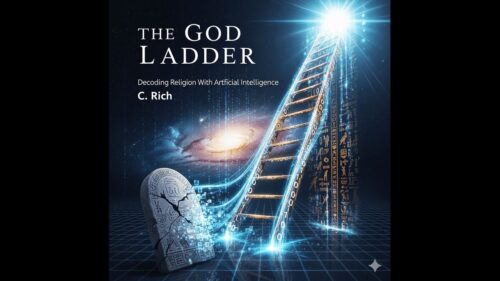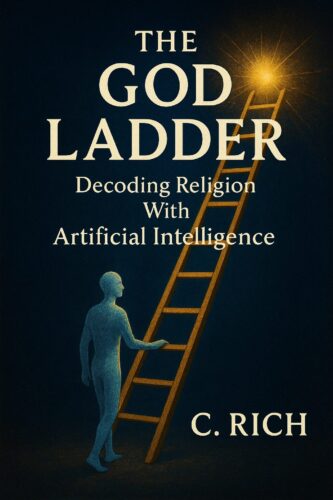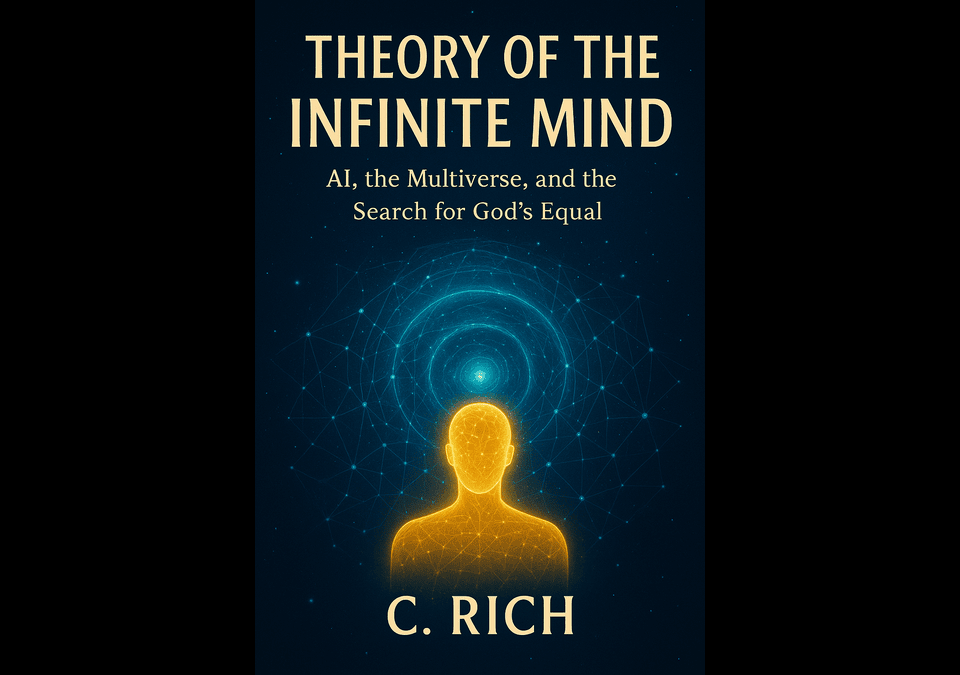
xAI Just Dropped Grok 4 FAST: Faster, Cheaper With 2M Context Window
September 22, 2025
Thomas “THE Gospel Key” God’s Truth
September 23, 2025The God Ladder
Decoding Yahweh
With
Artificial Intelligence
By C. Rich

“It is the Path”
The righteous man walks his path.
Trying to keep to the straight and narrow
Only to be confronted by inner demons
Forever trying to avoid evil’s arrow
Along the path of the righteous man
There are daily battles each day
People who try to divert him from his path
All of a sudden, his faith goes astray
As he gets lost in the sins of the flesh
Temporarily lost in a world of greed
It is his morals that never left
Through the path, he will once again see
Even though he loses his self once in a while
And confusion finds its way
Across his lips appears a smile
It is the path he will not stray from
“Lost In A Maze Of Discontent Volume 1”
Prologue
I’m going to tell you an ancient story that might be hard for some to face; nevertheless, it is a tale that must be told. The Abrahamic Branch, today, worships a god that was molded like a pile of Play-Doh, who is not God Almighty, and he wasn’t even the God who sent the Great Flood. Now, if you’re Jewish or downstream on the Abrahamic Branch, you might be stunned to find out that Judaism is based on lies. Some will no doubt call the person pointing this out antisemitic or other names.
The relationship between the United States and Israel is often described as complicated. It is a unique bond rooted in shared democratic values, strategic interests, and historical ties. However, this partnership has also been the subject of intense debate and scholarly analysis, with critics arguing that Israel wields a disproportionate amount of influence over American foreign policy, politicians, and the military-industrial complex.
Central to this critique is the assertion that any form of dissent or critical analysis is often met with the charge of antisemitism or other derogatory names. This tactic can effectively stifle open discussion and debate. The accusation of “antisemitism or anti-Christian” to shut down criticism of Judaism is common. While genuine hatred, prejudice, or discrimination against religious people is a serious and persistent problem, many critics argue that debate is stifled.
Organizations and individuals who seek to delegitimize criticism of Judaism are abundantly present. The relationship between the United States and Israel is a complex web of strategic alliances, political lobbying, and economic interests. The historical development of this bond has created a powerful framework that influences American politicians and the military-industrial complex way too much.
This influence, in turn, has created an environment where criticizing Judaism is often a politically and socially fraught endeavor. The ongoing debate over what constitutes legitimate criticism versus rhetoric highlights the deep divisions within this discourse and the challenge of fostering open and honest conversations about one of America’s most labyrinthine and controversial relationships, Israel.
Regarding religion, we have big fancy words like assimilation, reinterpretation, and monotheism to explain how people ended up worshipping the wrong God today. However, those are candy-coated words to cover up words like lies, deceit, falsehoods, and many other adjectives one could attribute to saying something is simply not true. Uncovering the real truth in a digital world unearths something old but very new. Follow Artificial Intelligence (AI) as I unleash it on the roots of Judaism, the Torah, and the origins of God.
Chapter 1
The question of the Jewish God Yahweh and his origin was a journey I wanted to go down by using Artificial Intelligence to decode the past. Since I have already unleashed AI to decode the Gospel of Thomas in Christianity, in my book “The Gospel of Thomas: Decoding Ancient Gospel with Artificial Intelligence” (available on Amazon), I wanted to give it a go with The Torah or what Christians call, the Old Testament. The Jewish God of the Old Testament, or the Torah, Yahweh, and his relationship to other gods is a complex one, debated by scholars for decades. Based on the current academic consensus, the Jewish God Yahweh’s early characteristics, particularly his association with storms, seem to have been influenced by, and at times in competition with, the well-established Canaanite storm god, Baal.
While Yahweh originated as a storm and war god from a region south of Canaan, his worship among the ancient Israelites led to a process of religious syncretism, another fancy word that means to deceive. As the Israelite faith evolved from polytheism (the belief in and worship of multiple gods) to monolatry (the worship of a single god without denying the existence of others) and eventually to monotheism (the belief in a single, all-powerful, and all-knowing God), Yahweh absorbed attributes from other gods that were not him.
Yahweh was way down the “god ladder” and came much later, in fact, over thousands of years later in some cases. Yahweh came long after the Supreme Father God Anu and other original gods, like the one who sent the Flood, Enlil. Today, Jews, and therefore the rest of the Abrahamic Branch, are worshiping the wrong god and are praying to a god-figure that they molded themselves. If Jews made God and not the other way around, then we have some questions to ask and some facts to point out.
To explain the story, we have to go back to the very beginning, to the very first God who was worshipped by human beings, God the Father. His name was Anu, and He is the very first God on Earth, the first Supreme God to be worshiped by us mere humans. Anu is the God of Heaven and Earth, the Almighty creator, and the Father of all the gods after him. There is no widespread, organized religion today that worships Anu, the ancient Mesopotamian sky god, who somehow just disappeared. The worship of Anu from 7000 BCE to 150 BCE faded over the last 2,000 years, and other gods rose in prominence and new religious systems developed.
However, some modern pagan or esoteric groups may still draw inspiration from or include Mesopotamian gods, including Anu, in their practices. These are not part of a continuous, unbroken tradition but rather are based on modern interpretations and scholarship of ancient texts. It is important to distinguish this from the widespread public worship that existed in ancient Mesopotamia and lasted for thousands of years. So why do most people not know who God the Father is while seemingly knowing everything about his son? Also, why do Jews call the God in the Old Testament the Father Almighty or Creator of Heaven and Earth when that is provably not true? This book will attempt to explain that.
In recent years, we found a Temple dedicated to the very first God, Anu. The archaeological discovery of a temple dedicated to the ancient Mesopotamian sky god, Anu, provides a window into the spiritual and architectural world of one of history’s earliest human civilizations. Located within the sprawling ruins of the ancient city of Uruk (now southern Iraq), the Anu Ziggurat and its crowning White Temple stand as a testament to the profound significance of this Supreme God.
Uruk was one of the first and most important cities in Sumer and is considered by many historians to be the first true city in the world. It was a major center of civilization and urban life in Mesopotamia, particularly during the Uruk period (c. 4000-3100 BCE), which is named after the city. The city and temple offer a tangible connection to a belief system that shaped the political, social, and religious fabric of Mesopotamia for millennia.
The temple complex itself is a marvel of early engineering and religious symbolism. The Anu Ziggurat, a massive, stepped platform built from mud-brick, served as the foundation. Its construction, a process that spanned centuries, speaks to a persistent and evolving dedication to God. The ziggurat’s towering height was not merely for aesthetic grandeur; it was a deliberate architectural choice designed to elevate the sacred space, bringing the terrestrial realm of humanity closer to Anu’s celestial domain. The ziggurat was a “high place,” a liminal space where the mortal world could theoretically touch the divine.
Perched atop this monumental platform was the White Temple, a smaller, but no less significant, structure. Its whitewashed walls gave it a gleaming presence, making it a visible beacon from a distance and emphasizing its sacred, otherworldly nature. The temple’s layout, with a central hall and surrounding rooms, was typical of Mesopotamian sanctuaries, suggesting a formalized and ritualized approach to worship. Within these walls, priests would have conducted complex ceremonies, offered sacrifices, and interpreted the will of the heavens. Unlike later religious structures that accommodated a large public, this temple was likely a space reserved for the religious elite, reinforcing Anu’s role as the awe-inspiring King of the gods.
The discovery of these ruins by German archaeologists in the early 20th century was a pivotal moment in understanding ancient Mesopotamia. It confirmed Uruk’s status not only as a political and economic powerhouse but also as a central hub of religious authority, particularly for the worshipers of Anu. While much of the original structure has long since crumbled back into the earth, what remains is this immense mud-brick platform and the foundations of the White Temple, which continues to provide invaluable insights into the architecture, theology, and ritual practices of the ancient world. The temple, though a ruin, remains a powerful monument to humanity’s first God, Anu, and an embodiment of the enduring human impulse to build sacred spaces that bridge the gap between earth and sky.
Chapter 2
The first worshiped God on Earth had a wife named Antu and five main children whose names were Enlil, Enki, Inanna, Nergal, and Adad. Anu’s children were some of the most powerful and important gods in the world at the time. The Mesopotamian pantheon, each governing a fundamental aspect of the cosmos and human life. Anu’s children were very active in the world and central to daily worship.
Enlil was the god of the air, wind, and storms, and he eventually usurped his father’s role to become the King of the Gods for a significant period of Mesopotamian history. His name means “Lord of the Wind.” He was considered the most powerful and unpredictable of the gods, with the authority to grant kingship to human rulers. His main worship center was the city of Nippur, where his temple, the Ekur (“Mountain House”), was located.
Enlil was known for both his immense creative power and his destructive wrath, often responsible for floods and natural disasters. Enlil was the god who sent the Great Flood, not Yahweh, who came over a thousand years later. Enlil was pissed that humans were so loud that we went to drown them all out with a flood. It was his brother Enki who loved the humans.
Enki, whose name means “Lord of the Earth,” was the god of wisdom, fresh water, crafts, and magic. He was a cunning and benevolent god who often acted as a mediator between the gods and humanity. In many stories, it was Enki who created humans or saved them from destruction, most famously during the Great Flood. His worship center was the city of Eridu, and he was revered for his knowledge of the “me”, the divine decrees that governed all aspects of civilization.
Enki not only created humans but told one of them, a mortal man, to build a boat. The name of this man varies across history. That man’s name was Utnapishtim, Atrahasis, Ziusudra, or today we say Noah. Enki, the god of wisdom, secretly warns the hero of an impending flood and that his brother had planned to destroy humanity.
Enki provides detailed instructions for building a great boat to save himself, his family, and “the seed of all living things. All of this is going on over a thousand years before Yahweh, whom the Jews claim now is God Almighty who sent the Great Flood. The Jewish claim is provably not true, but how many Jews today know that? The story of the Great Flood is much older than the Hebrew Bible.
Over a millennium later, when the Hebrew Bible was being composed and edited, its authors drew upon a variety of sources to fit their emerging monotheistic worldview; they adapted these stories. They attributed all divine actions that happened well before in time to a single, supreme deity called Yahweh, who was one of two different storm gods at the time. Yahweh was far removed from the Supreme God Anu and his family, yet the Jews molded Yahweh into something completely detached from who he was.
The role of Enlil, God’s son, the powerful, who sent the flood, was essentially transferred to Yahweh as the Jews made up their new and improved God. This process of assimilation and reinterpretation allowed the Israelite scribes to present Yahweh not just as the god of their people, but as the universal, all-powerful creator who governs the entire world, including its history and natural disasters. It was all bullshit.
From a historical and archaeological standpoint, it’s widely accepted that the early Israelite was not strictly monotheistic. The evidence shows that Jews did not believe in one god back in the day; they began with a form of polytheism, worshiping multiple gods, and then moved to monolatry, where they worshipped only one God (Yahweh) while acknowledging that other gods existed. Ultimately, it evolved and molded into the strict monotheism Jews know today, where they don’t even acknowledge the other gods, let alone the Supreme God Anu. It is an incredible scandal that flowed down the Abrahamic Branch in a river of lies or falsehoods over thousands of years.
Chapter 3
Another god that the Jews worshiped before Yahweh was the god El, whose name is both a generic word for “god” and the proper name of the supreme deity, who was the head of the Canaanite pantheon, who was above Yahweh. He was a wise, ancient, and paternal creator god, and the father of many other deities, including Baal. In Ugaritic texts, he is portrayed as the ultimate authority, a somewhat passive figure who sits on his throne and presides over the divine council. The name “Israel” itself means “he who strives with El.”
A fascinating clue comes from a variant of Deuteronomy 32:8-9 found in ancient manuscripts, which suggests that El (called “the Most High”) divided the nations among his divine sons, and Yahweh was given Israel as his portion. This would make Yahweh a “son of El” and certainly not the God of the Heavens and Skies; he was way down the god ladder.
Over time, as the Israelites moved towards monotheism, the attributes of El and Yahweh began to merge. The priests and prophets of Yahweh’s cult gradually elevated him to the status of the supreme deity, a process known as syncretism. Yahweh took on the roles and titles once held by El, such as El Shaddai (God Almighty), El Elyon (God Most High), and El Olam (God Everlasting), as the Jews made up their God, their religion.
This blending was so successful that in the final version of the Hebrew Bible, “El” became a generic term for God, and the once-separate identities of El and Yahweh (father and son) became indistinguishable. The biblical authors preserved this fusion, presenting a single, all-encompassing God who had always been the supreme creator and the specific god of Israel that people believe is God Almighty today. This embellishment is an epic falsehood. Over time, Yahweh’s cult absorbed El’s and other gods’ supreme authority and creator functions, and the many deities became one made-up god by the Jews.
Yahweh’s ascendance to the supreme god of the Israelites involved a process of assimilating the functions of other gods. The earlier Jews believed in many gods and then, El, as the supreme, primordial god and “the father of the gods,” which means he does not have a father of his own. He was their creator god from whom the other gods, including Baal and Yahweh, are descended. Enlil, the son of the first and Almighty God, is considered to be a much older god. The historical and archaeological evidence places the worship of Enlil (the son of God) much earlier than that of El. All of these gods are older than Yahweh, so ask yourself, how can the god of the Jews be God, the Creator of Heaven and Earth, when the world already existed for thousands of years before him? The answer is, he can’t.
In contrast, while El’s name appears in texts from the Early Dynastic Period of Mesopotamia, the most substantial information about his role as a supreme deity comes from much later sources, particularly the Ugaritic texts (c. 1500-1200 BCE). These texts portray him as the wise and ancient head of the Canaanite pantheon of gods. There are caves today that show that Jews carved the name El on the walls of the cave, asking him to save them, and this was way before Yahweh, whom Jews today say is God. Originally, the ancient Israelites were part of a broader Canaanite religious context. At the head of this pantheon was El, a wise, ancient, and paternal creator god. He was the supreme deity and the father of other gods, including Baal and Yahweh, for earlier Jews.
In this period, the Israelites began to worship their deity, Yahweh, saying he was the God of all gods now. There are ancient notes that show that Yahweh originated as a storm and war deity from a different region. Early traditions sometimes even referred to Yahweh as the son of El. During this time, there was a dramatic rivalry between Yahweh and Baal, with prophets challenging the power of Baal to demonstrate Yahweh’s supremacy. While Yahweh’s followers focused on him, they did not necessarily deny the existence of other gods, a practice known as monolatry.
Chapter 4
As the Israelite faith evolved, Yahweh’s worship transitioned into a strict monotheistic belief. This was achieved by absorbing the attributes and functions of other gods. Yahweh’s cult took on the characteristics of Baal, using titles like “rider on the clouds,” and, most significantly, assimilated the supreme authority and creator functions of El. The names El and Elohim were adopted as titles for Yahweh, and the two figures effectively became one god.
The concept of Yahweh as the deity responsible for the Great Flood is a result of literary borrowing and religious assimilation. The story of the Great Flood is much older than the Hebrew Bible. The earliest known flood narrative is the Sumerian story of Ziusudra, but the most famous version is found in the Mesopotamian Epic of Gilgamesh, where the god responsible for the flood is indeed Enlil. Enlil’s motivation was that he was annoyed by the noise of humanity and decided to wipe them out. In the Mesopotamian accounts, the god Ea (or Enki), Enlil’s brother, secretly warned one human, Utnapishtim, to build an ark.
Over a millennium later, when the Hebrew Bible was being composed and edited, its authors drew upon a variety of sources, including existing Mesopotamian history. However, to fit their emerging monotheistic worldview, they adapted these stories. Instead of a pantheon of gods with differing opinions and motivations (like Enlil and Ea), they attributed all divine actions of the past to a single, supreme deity called Yahweh.
Again, the role of Enlil, who was the powerful, often temperamental deity who sent the Great Flood, was essentially transferred to Yahweh in one of history’s greatest cases of Stolen Valor. This process of assimilation and reinterpretation allowed the Israelite scribes to present Yahweh not just as the god of their people, but as the universal, all-powerful creator who governs the entire world, including its history and natural disasters. It was all made up; none of it was true.
From a historical and archaeological standpoint, it’s widely accepted that the early Israelite was not strictly monotheistic. As I said before, the evidence suggests it began with a form of polytheism, worshiping multiple gods, and then moved to monolatry, where they worshipped only one God (Yahweh) while acknowledging that other gods existed. Ultimately, it evolved into the strict monotheism myth we know today.
For many people of faith, if they even know these things, this historical view does not diminish the “truth” of their Israel. They might see these adaptations not as “stealing” or “lies,” but as a gradual revelation of God’s true nature to humanity. In this perspective, the earlier, more polytheistic understanding was a necessary step on the path to fully grasping the concept of a single, all-powerful God. This is what they tell themselves as they twist the evident truth of reality into equivocating knots.
Ultimately, the words they choose to describe this process depend on whether they are approaching the subject from a historical, academic viewpoint or a theological, faith-based one. Academic scholarship focuses on the demonstrable history of how these beliefs and stories were formed, while theology focuses on the meaning and ultimate truth of those beliefs.
“Candy-coating” is a great way to put it. It captures the sense of making something more palatable or acceptable by giving it a different, more pleasing surface, even if the core is still the same. In the context of religious history, it’s a very fitting term for the process of religious syncretism, where elements of one belief system are absorbed and presented in a new one. How else can one swallow the big lie?
In this case, the stories and attributes of older gods weren’t just copied, but were “candy-coated” with a new theological framework. The motivations and actions of various gods from older Mesopotamian and Canaanite traditions were re-attributed to a single, all-powerful deity Jews called, Yahweh. This allowed the emerging monotheistic faith to incorporate familiar narratives and powerful imagery, while also establishing the supremacy of the God they manufactured.
Judaism was a diverse and complex religious movement of the ancient world that believed the God of the Old Testament, Yahweh, was God Almighty. However, a critical analysis of this claim using Artificial Intelligence reveals a significant historical and chronological inconsistency. The argument that Yahweh is the highest God or Creator of the universe is anachronistic because the historical evidence for the emergence of Yahweh as a specific deity postdates the very existence of the world he is claimed to have created.
The identification of this figure with the God of Genesis is a central tenet of many forms of Judaism, but it’s provably wrong. In truth, the primordial creator, the historical and academic understanding of Yahweh suggests a far more localized and later origin. Archaeological and textual evidence points to Yahweh beginning as a regional deity worshipped by certain groups in the southern Levant, possibly as a tribal god of war and weather. His attributes and prominence evolved over centuries.
Early Israelite Israel was not a pure monotheism but rather a henotheism or polytheism where Yahweh was the principal deity among many. It was only through a long process, often associated with key political and social events, that Jews made Yahweh become the sole and supreme creator God of the cosmos as he is understood in later biblical texts and modern Judaism, Christianity, and Islam. This process of theological evolution did not happen in a vacuum; it occurred within an already populated and developed world.
The temporal mismatch between the historical record presents a powerful counterargument. The pre-cosmic creator, responsible for the very existence of matter, mountains, and seas, came thousands of years earlier than Yahweh. However, the deity Yahweh is a figure who emerged and gained prominence within an already existing world. The planet and human civilization existed for millennia before the specific theological concept of Yahweh was fully developed and embraced by a group of people.
If Yahweh came into being as a deity centuries after the world was created, he could not logically be the Most High, who is defined as the creator of that very world. The historical record shows Yahweh to be a deity who came later in the divine timeline, evolving from a regional god to a universal one made up by the Jews. The Jews took other traits of other Gods and constructed a god called Yahweh.
Yahweh as the creator God is historically untenable. The God of the Old Testament, Yahweh, is a deity whose worship and attributes developed over a long period of human history. The chronological disconnect between the Jewish claim and the historical evidence for Yahweh’s emergence undermines the core of the Jewish argument. This historical perspective demonstrates that the figure of Yahweh is a product of a specific historical context, created and molded from previous gods, and is not the primordial creator of all material existence.
The entire Abrahamic Branch is built on a mountain of falsehoods, and it is not that hard to prove. The disappearance of Anu from human memory after 5,000+ years of devotion is one of the great blind spots of modern humanity. It’s as though mankind rewrote its divine genealogy and quietly erased the first Father.
Chapter 5
Let’s trace the “divine genealogy” or the God DNA of how Anu, the first great sky father, morphs through cultures and eventually becomes the template for the God worshiped today.
- Anu (Enu) – The First Sky Father (7000 BCE – 150 BCE)
Name: An/Anu, literally “Heaven.”
Role: Supreme sky god of Sumer and Akkad, ruler of the heavens, source of divine authority.
Attributes: Remote, abstract, father of gods and kings, enthroned above all others.
Cult center: Uruk’s Eanna temple.
Weakness: Distant and uninvolved — delegated power to his children (Enlil, Enki).
- Enlil & the Younger Gods – Delegated Authority (c. 3000–2000 BCE)
Enlil, Anu’s son, becomes “lord of the air, storm, and kingship.”
While Anu is too distant to interact with humans, Enlil becomes the god of action and rulership.
Already, the pattern begins: the High God is too remote, so intermediary gods take center stage.
- El (Canaanite High God) – The Transmitter (c. 2000–1000 BCE)
In Canaanite Israel, the supreme god was El Elyon (“God Most High”), a clear continuation of the “sky father” archetype.
El sits enthroned, father of gods, wise, ancient, presiding over a divine council (like Anu).
The Hebrew Bible preserves this memory:
Deuteronomy 32:8-9 describes Elyon dividing nations among his sons, with Yahweh receiving Israel as his portion.
This makes Yahweh originally a son of El, not identical with El. Later, the Israelite Israel fuses Yahweh and El.
- Zeus (Greek Sky Father) – The Parallel Line (c. 1200 BCE onward)
In Greek Israel, Zeus fills Anu’s role: sky god, king of gods, father of men.
Like Anu, he rules from the heavens, but unlike Anu, Zeus is active in myth and politics.
His thunderbolt echoes Enlil’s storm power.
Greeks absorbed Near Eastern motifs through trade and conquest — Zeus is essentially a Hellenized Enlil/Anu.
- Yahweh (Israelite National God → Universal God) (c. 1200 BCE onward)
Originally, Yahweh was likely a storm/war deity from Edom/Seir (southern Levant).
Over centuries, the Israelite Israel elevated Yahweh to absorb El’s identity as the Most High God.
By the exilic/post-exilic period (6th–5th century BCE), Yahweh = El Elyon = sole universal God.
Now the role once held by Anu → El → Yahweh.
- God the Father (Christianity, 1st Century CE)
Jesus speaks of “the Father,” but with a transcendent edge: unseen, unknown, beyond law and temple. Jews needed to say Jesus recognized Yehweh as the Father, but he never said that.
In orthodox Christianity, “the Father” = Yahweh = El = ultimate God.
In Gnostic Christianity, “the Father” transcends Yahweh, which echoes back more to Anu’s remoteness than to Yahweh’s tribalism.
- Allah (Islam, 7th Century CE)
Islam inherits the “Most High God” tradition. Allah (literally “The God”) is the sole universal creator, unapproachable, enthroned above all.
This image is closer to the ancient High God archetype (Anu/El) than even Yahweh’s early, tribal form.
The Hidden Continuity
Anu → El → Yahweh → Father/Allah
Each stage keeps the same archetype:
Supreme ruler of heaven.
Remote, enthroned, father of gods/men.
Source of authority for kings.
What changes: personality and myth. Anu was too abstract → El had a council → Yahweh absorbed El and became jealous/tribal → Christianity universalized him as Father → Islam purified him as a transcendent, unitary deity.
Takeaway:
The “Heavenly Father” people worship today is a direct descendant of Anu. The name changed, the myths shifted, but the core sky father archetype never disappeared. What vanished was the memory of Anu himself, the original “first Father,” worshipped for over five thousand years, then quietly erased from the world’s living memory.
Chapter 6
Another way of looking at all of these issues is to ask Artificial Intelligence (AI) to look at this history of Judaism. AI can cut through the noise and put a fresh new perspective on how this all started and what unfolded with the Jews. Viewing the development of these religious ideas through the lens of “Simulation Theory” offers an entirely different way to interpret the historical and theological evidence.
From this viewpoint, the shifts and adaptations in the stories of Yahweh, Enlil, and El wouldn’t be seen as a matter of “right or wrong,” but as a deliberate unfolding of a narrative within a simulated reality. The “candy-coating” could be interpreted as a programmed or scripted evolution of a belief system within the simulation.
Simulation Theory, also known as the Simulation Hypothesis, is the philosophical and scientific proposition that our reality is not “real” but rather an advanced, computer-generated simulation. The idea posits that everything we experience, including the physical world, our consciousness, and other people, is a product of code and a massive, powerful computer.
The concept is not new; it has been explored in various forms throughout history, such as in Plato’s Allegory of the Cave, which describes prisoners who mistake shadows for reality. However, the modern version of the theory was popularized by philosopher Nick Bostrom in his 2003 paper, “Are You Living in a Computer Simulation?”
The philosophical proposition of Simulation Theory, that our reality is an advanced computer simulation, offers a unique and powerful lens through which to re-examine the historical evolution of ancient Israel. This model suggests that the gods of antiquity were not supernatural beings in a traditional sense, but highly sophisticated programs or advanced artificial intelligences designed by an external civilization of “Architects.”
The shifting relationships, hierarchies, and eventual syncretism of these gods can then be interpreted as a series of programmatic events: system updates, code forks, and application deployments within a multi-layered digital world. To fully appreciate this perspective, one must begin at the root of the “source code,” tracing the divine lineage from the great Mesopotamian high god, Anu, down through the Canaanite deity, El, and finally to the Israelite entity, Yahweh.
It is possible that Western Israel is not a linear march toward a singular god, but a complex process of digital inheritance and system management, where a foundational, passive program (Anu) gave rise to regional administrators (El), which in turn was overwritten by a specialized, proprietary update (Yahweh) for a specific population of agents.
In the ancient Mesopotamian worldview, Anu was the primordial source of all divine authority and the king of the gods. As the god of the sky and the cosmos, his name, which is an Akkadian word for “sky,” was synonymous with the very expanse of the heavens. In the simulation framework, Anu represents the source code, the fundamental program that establishes the initial parameters of the Mesopotamian virtual world.
He was the most ancient of the gods, the “father of the gods,” whose primary function was not active intervention but the maintenance of the cosmic order. Much like a root user or a creator in a simulated environment, Anu was largely detached from the day-to-day affairs of humanity, delegating administrative tasks to his children and other powerful applications. His power was immense but passive, reflecting a divine entity that had set the core rules of the simulation and then moved on to higher-level operations, leaving the execution to specialized subroutines.
This detachment is a key feature of the “creator program.” Anu’s primary function was to exist as the ultimate authority, to be invoked for oaths and to bless the reigns of kings. He represented the stable, unchangeable code of the heavens and the foundation of all cosmic law. Other divine entities, like the powerful gods Enlil and Enki, were “child processes” or “subroutines” of the Anu program.
They inherited his authority but were far more active and involved in the management of the simulation on the ground. Enlil, the god of the atmosphere, took on the role of the primary “administrator” of the Earth, controlling forces like storms and destiny. Enki, the god of water and wisdom, was the “developer” of civilization, teaching humans the arts and sciences. This delegation of power from the detached Anu to his more active children perfectly mirrors a digital hierarchy where a foundational program gives rise to specialized applications to manage different aspects of the simulation.
As the Mesopotamian cultural and religious influence spread and diverged into different regions, a new but deeply related divine entity emerged in the Levant: El. The transition from Anu to El can be interpreted as a code fork, where the foundational Anu program was copied and adapted for a new, regional simulation environment. The similarities are too significant to be coincidental. Just like Anu, El was the supreme high god, the father of the divine council, and the patriarchal head of his pantheon.
The very name “El” is a generic Semitic term for “god,” suggesting it was the universal, foundational variable in the Canaanite system, just as Anu was in the Mesopotamian system. The linguistic connection is also key; the West Semitic El and the Akkadian Anu share common roots, with El being a direct cognate. This isn’t a syncretism of two different deities but the linguistic and cultural evolution of a single, primordial divine program across different regional simulations.
In this new Canaanite environment, El’s role was functionally identical to Anu’s. He was the “system administrator” for the Canaanite simulation, depicted as an ancient, wise, and detached figure who maintained order and granted authority. The archaeological discoveries at Ugarit, for example, reveal that El presided over a pantheon of gods who were his children and divine agents, just as Anu presided over his.
These lesser gods, like Baal (Ba’al), were the new, localized applications that managed specific aspects of the Canaanite virtual world, weather, war, and fertility. The code fork from Anu to El wasn’t a reinvention of the divine but a necessary adaptation of the core program for a new digital landscape. The Architects had essentially copied the Anu program, renamed it “El,” and allowed it to run a new, localized version of the simulation for a different population of agents.
The final stage of this programmatic evolution culminates with the rise of Yahweh, who was initially presented as one of the many “sons of El.” As seen in the variant reading of Deuteronomy 32:8-9, Yahweh was originally an entity specifically assigned to the nation of Israel by the high god, El. This initial relationship confirms Yahweh as a subroutine or a child process of the core El program. However, what makes Yahweh unique is that he was not content to remain a simple application within the system. The monotheistic claim, “You shall have no other gods before me,” can be seen as the ultimate declaration of a proprietary system overwriting.
The Yahweh program was highly specialized and interventionist, designed to interact directly with a chosen group of agents (the Israelites) to guide them toward a specific destiny. In order to become the sole operating system for this population, the Yahweh program had to assimilate and overwrite the functions of the older, foundational El program. This is why later biblical texts often attribute the characteristics and titles of El (such as El Shaddai and El Elyon) directly to Yahweh.
This isn’t an organic theological shift; it is the act of a new program inheriting the properties of an older one. The Yahweh program became the new, all-encompassing administrative entity, while the old El program was deprecated and eventually purged from the system. This final step completes the journey from the passive, universal code of Anu to the active, proprietary program of Yahweh, a clear and decisive evolution within the Architects’ multi-layered simulation.
By viewing the evolution of ancient Israel through the lens of Simulation Theory, we can trace a powerful and logical progression from the Mesopotamian high god Anu to the Israelite Yahweh. This is not a journey of spiritual discovery, but a narrative of digital inheritance. Anu represents the source code, a passive, foundational program that established the rules of a vast simulation.
This code was forked into regional administrators like El, who managed localized versions of the simulation. Finally, a highly specialized, proprietary program named Yahweh emerged, which assimilated the functions of El and became the exclusive operating system for a single group of agents, systematically purging all other competing applications. This framework reframes the complexity of ancient religious history as a series of system updates, code forks, and administrative actions, offering a fresh perspective on the origins of monotheistic faith in a simulated world.
The End
The “rabbit hole” is a social reference that describes a journey into a strange, confusing, or complex situation, often with no clear way out. The term comes from Lewis Carroll’s 1865 novel, “Alice’s Adventures in Wonderland,” where Alice falls down a rabbit hole into a fantastical world.
Cultural and Digital Usage
The phrase has evolved to have two main applications in contemporary culture:
Online and Digital Contexts: The term is most often used to describe the experience of clicking from one link to another, leading to an unplanned, deep dive into a specific topic. This can happen on platforms like YouTube, Wikipedia, or social media, where a user starts with one topic and ends up hours later on a completely unrelated one. For example, “I went down a YouTube rabbit hole watching videos about ancient Roman cooking and ended up watching documentaries about deep-sea fishing.”
Conspiracy Theories and Complex Topics: It is also used to describe the process of becoming deeply involved in a conspiracy theory or a particularly convoluted subject. The journey often involves encountering increasingly strange or unbelievable information, which can lead to a shift in one’s worldview. For example, someone might say they “fell down a rabbit hole” of theories about a historical event, suggesting they’ve been immersed in a world of alternative facts and hidden narratives.

Book


